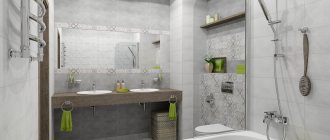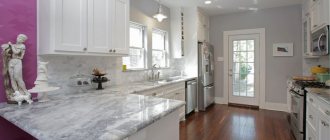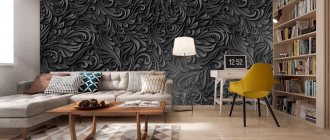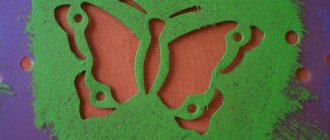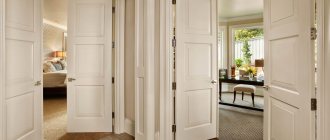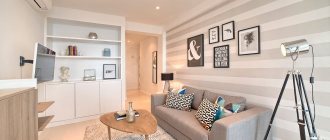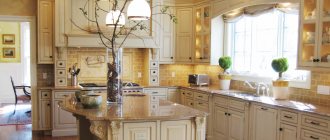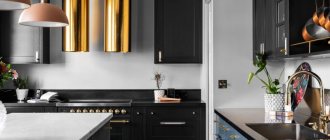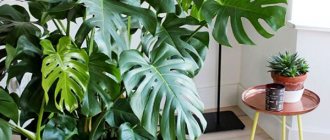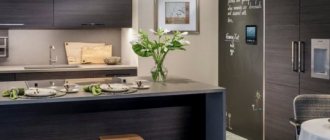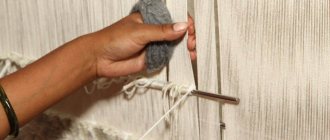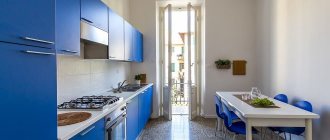Mirror in the kitchen - why not! While some people like to look at it while preparing a romantic dinner, others use it in a different capacity...
The use of mirrors in the interior is different - from decorative to functional. For example, to make a small kitchen visually large, many techniques are used, one of which is mirrors.
The sun's rays, reflected from the mirror surface, fill the room with light, illuminating every corner of it.
So what can be mirrored in a room? Let's look at everything in detail.
Mirror slabs on the kitchen wall
What is the mirror made of? The material matters.
Before rushing into search for a mirror in various places in the vastness of the kitchen, let’s turn to the source of the issue. Let's talk about its production. The mirror can be based on polystyrene, acrylic, or glass.
- Mirror polystyrene (plastic) has a glossy surface, like a glass mirror. When producing mirror effect plastic, metal foil is used, which is placed between a transparent laminating film and an impact-resistant base. Mirror polystyrene can be used to decorate any room, including the kitchen. The surface of the material is available in two colors: gold and silver. Among its advantages: – long service life, – impact resistance, – low sensitivity to any mechanical damage, – resistance to low temperatures, humidity, – does not change color over time, – lightness of the material, – ease of maintenance, – ease of installation – for To decorate kitchen surfaces, you will only need liquid nails - an environmentally friendly material that does not release toxins or other toxic elements when burned.
- Mirror acrylic plastic (plexiglass) is a type of mirror polystyrene, and, accordingly, has all its advantages. The main disadvantage of acrylic is its softness; scratches and other mechanical damage easily remain on the surface of this material. Therefore, a protective coating is used to protect acrylic mirror surfaces. Mirror acrylic plastic is less flexible compared to polystyrene. At the same time, it is more durable and smoother. It can be made in any color.
- Glass . This is the most common and high-quality material. The technology for creating a mirror on glass is easy to understand. To ensure that the reflection is without distortion, both glass surfaces are carefully polished. Then the surface is coated with a chemical composition (usually a silver solution), after which everything is covered with a special protective layer. Unlike acrylic, glass is heavier, so these mirrors will weigh much more. The cost of a glass-based mirror is much higher.
Types of mirror engraving
Manufacturing materials
The very first mirrors began to be made in the middle of the Bronze Age; they were cast from tin, copper or bronze. In the 13th century, the technology was improved - glass began to be used, and by the end of the century, workshops for the production of mirrors appeared. It was only in the 18th century that silver began to be used; it was applied to the back surface of the glass.
Modern mirrors consist of several parts - glass and a special reflective layer. They should give a realistic and undistorted image. The following components are used in production:
- carbonate salt of calcium and magnesium;
- soda;
- coal;
- sand;
- feldspar;
- limestone.
The composition should not contain iron salts (a minimum amount is allowed). This is necessary in order to avoid unwanted greenish coloration.
Mirrors can be made not only on a glass base; acrylic is also used. It gives the finished product strength; such surfaces are easy to transport and convenient to install. The disadvantages are the high price and susceptibility to mechanical damage, such as scratches.
Mirrors in kitchens of different styles
It is believed that a mirror surface is suitable for rooms of any style. Mirrors are most suitable for high-tech, classic, and modern style kitchens. Interior decoration with mirrors with an aging effect is best suited to country, art deco, and fusion styles. Such mirrors are created only in production, with a wide range of colors offered: from classic silver, bronze to colored.
Classic style kitchen with mirror
Examples of kitchen mirror designs
Original design ideas using mirrors.
Mirror mosaic
Artistic mirror elements have a slight reflective effect, giving the kitchen space a special airiness and at the same time exclusivity.
Panel
A decorative panel fills the room with a large amount of light reflections, creating the illusion of volume and giving the atmosphere magic and enchantment.
The photo shows a mirror panel on the wall above the dining area in a high-tech kitchen interior.
With facet
An incomparable reflective fabric with a facet not only visually enlarges the space, but also, due to the refraction of the edges, adds incredible radiance and shine to it.
Furniture with inserts
A cupboard or kitchen set with mirror inserts is a traditional design solution that allows you to give the interior some newness and originality.
The photo shows a kitchen in light colors with a suite decorated with mirror inserts.
With drawings
Canvases decorated with sandblasting designs significantly transform the kitchen environment, filling it with expressiveness and brightness.
Decorated mirrors
Thanks to a variety of fancy and spectacular frames, it turns out not only to make the mirror enchanting, chic and picturesque, but also to easily enliven the room, creating the right mood in it.
Backlit
The ideal symphony of light emanating from the backlight allows you to organically emphasize the shape of the mirror product and make it an exquisite interior decoration that will not go unnoticed.
Mirror wall in the kitchen
If your kitchen is elongated or small in area, then a mirror wall will be very helpful, making it visually larger. At the same time, it is not necessary to turn the entire wall into a mirror, unless you want to create the illusion of a crystal house.
You can mirror part of the wall, create mirror decor on the wall, etc. The design of the mirrors can be anything - you can create your own unique pattern. At the same time, the kitchen interior will sparkle with new colors. If the kitchen is combined with the living room, the decorative wall, which is the partition between the rooms, can also be mirrored.
The mirror wall has long ceased to be associated with a nightclub or cafe. And you definitely can’t call it bad taste. The main thing here is not to overplay, not to do harm, because from lightness and airiness you can involuntarily turn to burdensome and cloying. Installation of a mirror wall depends on the chosen material. Let's take a closer look at them.
Mirror wall in the kitchen
Mirror panel
The panel is a single composition on the kitchen wall, made of several mirror segments. At the same time, the individual elements of the panel do not necessarily have the same size, shape, or pattern. As is the case with any type of mirror, the panel can be artificially aged (this is especially suitable for some styles of kitchens, for example, country).
Mirror elements can be voluminous, which allows you to create abstract, incredible, mesmerizing, cosmic compositions. Using sandblasting, a mirror panel can have a specific picture on the wall. Photo printing, where a color picture is applied to the surface of the elements, is also possible. The resulting mirror composition can either complement the interior or be an accent in the kitchen.
If you place a sconce or other lamp next to the panel, the kitchen will be filled with additional light reflected from the mirrors. If you place a plant nearby, it will be reflected repeatedly from the mirror segments, refracting and doubling the amount of greenery in the room.
A mirror panel is perfect for zoning a room. This is most relevant in the case of a combined kitchen and living room. Then it would be best to place the panel in the dining area. In this case, both classic mirrors and abstract compositions are suitable.
Mirror panel in the kitchen
Mirror tiles
Mirror tiles placed on the kitchen wall are no different in shape from other types of tiles. This is a classic square or rectangle, with a pattern, a relief surface, tinted, with a bevel (bevel is a decorative treatment of the edge of glass), with inserts, with holography, etc. The edges of the tiles are processed in production to completely protect the client.
An alternative to classic mirror tiles on glass is polystyrene tiles . The upper part is covered with paint with metal particles that reflect light. In terms of material quality and reflective properties, polystyrene is very inferior to mirror tiles, so its price is lower. The advantage of polystyrene lies not only in cost, but also in ease of installation. This material is easy to cut, and thanks to the self-adhesive film, installation can be done independently.
Among the main disadvantages of using mirror tiles, we note that over time, due to the influence of high temperatures and humidity, darkening may appear on the surface of the material. We also add that the cost of tiles is higher compared to traditional tiles.
Mirror tiles have many advantages:
- variety in shape, color,
- long service life,
- flexibility of the material (mirror tiles based on plastic) - this will allow you to cover, for example, the intended curve of the wall,
- resistance to chemical liquids, moisture, corrosion,
- easy to clean (except for seams, where dust and dirt can accumulate).
Mirror tiles on the kitchen wall
Mirror panels
Mirror panels, as we have already written, are based on either plastic or glass. Accordingly, the differences between them will be in weight, cost, ease of installation, because the heavier the material, the more difficult it is to work with. Mirror panels can be made in a classic form, with the effect of an aged mirror, with patterns, in different colors, with a relief surface.
Plastic-based panels can be installed even on uneven walls. It will be more difficult to do this with a glass base; also, with a mirror surface, any unevenness of the wall will turn into a distortion of the reflection. Therefore, the wall should be as flat as possible in any case.
High temperatures can damage plastic mirror panels, so you should not place them on the wall near the stove. It is also necessary to install sconces and other lighting fixtures with high incandescent temperatures with care.
When installing mirror panels, glue is used. But in the case of a material with a glass base, it will not be possible to dismantle it carefully - the mirror cannot be reused, it will be damaged, no matter how hard you try. For plastic panels, you can use screws, nails, and staples. You can also purchase panels on a self-adhesive basis - there will be no problems with installation at all.
Mirror panels on the kitchen wall
Mirror stickers
In order to decorate the kitchen without loading it with colorful drawings and pictures, you can purchase mirror stickers (stickers). They are glued to any surface using special tape, usually included in the kit. For stickers, a wall is most often chosen, preferably a plain one. Mirror stickers are suitable for any wall shade, with the possible exception of white and light gray, on which they will get lost. In this case, it is better to choose colored mirrors or with an aging effect.
The stickers are based on an acrylic mirror , which is easily glued to the wall (wallpaper, wood, glass, plaster, paint). At the same time, you should not be afraid that they will fly off over time. The shape of the stickers is very different: from circles, squares, stars, to a scattering of small mirrors, words and even full-fledged compositions.
Sunlight, falling on the stickers, will “play”, filling the kitchen with sunbeams and a good mood. Even the smallest decor will be noticeable. Let’s share a little “secret” on how to make the reflection of mirror stickers colored. If, for example, a bright yellow sofa or a red refrigerator is located opposite them, then naturally this color will be reflected.
Among the varieties of mirror stickers we can highlight vinyl film . But its characteristics are much weaker than stickers, the quality of the product is also in question. Mirror film is not suitable for wall decoration. Due to the self-adhesive base, it can be placed on any type of surface, but the reflective effect is far from a mirror. The basis of this film is polyvinyl chloride. Its cost is low. A more expensive, but much higher quality material is polyurethane .
Mirror stickers on the kitchen wall
Mirror wallpaper
The use of mirrors as decor, including in the kitchen, began not so long ago. Now you can make almost everything mirrored: furniture, floors, ceilings and even wallpaper. They are made on a non-woven or paper base, on which a layer of aluminum foil is applied (hence another name for wallpaper - “metalized”), and a pattern is applied on top. The whole thing is covered with a layer of transparent varnish.
The palette will delight the client: shades of silver, bronze, gold. In addition, the coating can be matte or glossy - everything according to your desire. Mirror wallpaper is suitable for the walls of kitchens of different styles: classic, modern, modern, etc.
The main advantages of mirror wallpaper:
- They are not afraid of humidity, as they do not absorb moisture. This means they are not afraid of fungus, bacteria and mold. Wallpaper can be wiped with a damp cloth or sponge, wiping away dirt and dust.
- Long service life.
- Over time, it does not lose color and does not fade in direct sunlight.
- Wide range of wallpaper patterns and shades.
- Creating beauty, nobility and comfort in the kitchen.
Among the shortcomings we note:
- Poorly protected from mechanical damage. Even scratches can seriously damage the wallpaper. Therefore, if there are small children or animals in the family who like to scratch not only the owner, but also furniture and walls, this option will not work.
- Mirror wallpaper requires a smooth kitchen wall surface. Otherwise, the reflection will be distorted, and bulges, pits and irregularities will be very visible due to glare.
- High cost compared to conventional wallpaper.
A variety of mirror wallpaper
It is difficult to attribute the following fact about mirror wallpaper to disadvantages. When gluing them, it is necessary to turn off the electricity - this is their feature. The wallpaper contains metal components, as we have already written. They conduct current well, which can be dangerous when gluing wallpaper wet from glue. It is recommended to turn on the light after the wallpaper has completely dried.
It is also worth mentioning that you can purchase mirrored self-adhesive wallpaper, which can be used to decorate individual sections of the wall and even furniture. Rolls of such wallpaper are not wide, so they are not suitable for every idea. The quality of such a self-adhesive film will be inferior to mirror wallpaper, but it is suitable as a small decor.
Mirror wallpaper gives the room chic and elegance. Unfortunately, their price is high enough for anyone to purchase them.
Mirror wallpaper in the kitchen
Mirror kitchen set
Kitchen facades break all stereotypes. Photo prints, any color, reliefs, materials - everyone will find something of their own. The time has come for mirrored kitchen facades, and their presence in the house will be a whim for some, and a necessity for others. It's all about the property of mirrors to increase space.
If you want to hide the furniture in the kitchen as much as possible, order a mirror set. This can be either individual mirrored doors or the entire facade. The use of mirrors on the facade of a kitchen unit is possible in 3 options:
- Solid mirror facade . Here mirrors are installed over the entire surface of the facade. With full coverage of the set, you will get the feeling of the absence of furniture in your kitchen.
- Mirror inserts. Here, the frame for the mirrors will be the base of the kitchen unit, for example, chipboard. At the same time, mirror inserts can be made both on all doors and on individual ones.
- Spot decor. Here, the decor of the facade with mirrors will depend on your desire - shape, color, number of elements. When ordering a new set, the mirror decor will be done by specialists, but you can transform existing furniture by gluing self-adhesive mirrors yourself.
In order not to constantly wipe the furniture, you can order embossed, aged or matte-patterned mirror surfaces. Less easily soiled - embossed or artificially aged mirror facades. They are suitable for kitchens of different styles.
Mirror kitchen set
Placing a mirror above the table
Placing a mirror above the dining table is a bold decision. This option is rational only for small rooms. A mirror will visually expand it and make it more spacious. In other cases, the installation of such decor will not be justified.
An unusual but increasingly popular solution is to decorate the dining area with one large or several small mirrors.
Note! The mirror reflects absolutely everything. Even with the slightest mess in the kitchen, a mirror surface will double it.
In addition, some people like to lean their elbows or lean against the wall during dinner. If at this moment there is a mirror there, then in the best case, after a family dinner you will have to wash it immediately, and in the worst case, it may become deformed. To prevent such situations, you can choose small mirrors. They are placed all over the wall.
In the kitchen, separating the work area from the dining area plays an important role. This creates a more comfortable atmosphere and adds aesthetic charm due to interesting wall decoration. A beautifully designed dining area helps to avoid severe cluttering of the space, and in cases where the kitchen is small, it helps to visually expand it. There are many design solutions for decorating kitchen walls and everyone will definitely find something suitable.
In addition to the above options, there are quite a lot of different products designed exclusively for interior decoration.
Mirror Island
An island, as a rule, is made in a spacious kitchen, because otherwise there will be no room for it. Even in this case, this part of the furniture can be made invisible - the room will become even more spacious and bright. The entire island is covered with mirrors, even the tabletop if desired. If you want to create an atmosphere of mystery and romance in the kitchen, consider LED lighting. It can be placed under the tabletop along the perimeter of the table, as well as near the floor, creating the effect of a floating island.
Mirror island in the kitchen
Mirror floor in the kitchen
The simplest and most common type of mirror flooring in the kitchen is tile. The standard shape is square, but the manufacturer will make any shape and size upon request.
Polystyrene- based tiles cost less. Paint with metal elements for reflection is applied to its surface. Some tile models have a self-adhesive film, with which you can easily attach them to the wall yourself.
Glass- based mirror tiles will be a better and more durable option for kitchen floors . Such material will be more expensive and installation will be more difficult, but even after years your floor will not fade or deteriorate.
Mirror floor in the kitchen
Another type of floor slabs is acrylic mirror . There are no complaints about the quality. It is considered safer than glass, and is also almost 2 times lighter. But the disadvantages are a soft surface that is easily scratched, as well as the high cost of the material. Therefore, it is not very suitable for the kitchen floor.
Let's move on to more durable materials. Ceramics made from clay and quartz sand, as well as porcelain stoneware , are a guarantee of quality and safety. To obtain a mirror surface, porcelain tiles undergo a thorough, complex polishing technology. Accordingly, this increases the cost of the tile, and its appearance deteriorates over the years.
Another option for flooring in an apartment or house is laminated parquet with a mirror finish and a multi-layer structure. The material is protected from scratches, its surface is antistatic, so dust will not be attracted to it. The price of the material is high.
The mirror-glossy effect of laminated parquet was first proposed by the German manufacturer HDM Elesgo , which presented its mirror floors in the Superglanz floor . In this case, the color of the floor can be any. Unfortunately, the service life is short - up to 5 years.
Laminated parquet Superglanz floor in the kitchen
Mirror ceiling in the kitchen
The main advantage of placing mirrors on the ceiling is the feeling of spaciousness and freedom. A mirrored ceiling from edge to edge will give you the feeling of having no roof over your head. This technique is especially relevant for a small kitchen. What material will allow you to turn the ceiling into a mirror?
Mirror stretch ceiling
The glossy stretch ceiling also reflects light and acts as a kind of mirror. But technology has gone further - now it is possible to order a mirrored suspended ceiling. Of course, a mirror cloth will not replace a real mirror and will not be able to reflect objects 100%. But its mirror effect is quite noticeable and effective.
The main and only difference between a mirror stretch ceiling and a regular one is the canvas itself, on which a special mirror coating is applied - a thin but very durable polyvinyl chloride film. This does not affect the installation or quality of the material. In this case, you can choose any color of the mirror cloth.
This option is not suitable for kitchens with low ceilings. After all, installing a suspended ceiling, including a mirrored one, will take up to 5 cm of the kitchen height.
Among the main advantages of a mirrored stretch ceiling, we note:
- long service life,
- quality of material,
- does not lose color and strength over time,
- able to hold water when flooded by neighbors above,
- wide range of colors,
- moisture resistance,
- easy care,
- installation of all types of lamps,
- low cost of material.
Let's look at the disadvantages:
- will not replace a real mirror due to its reflective characteristics,
- accidental mechanical damage with a sharp object will damage the canvas,
- “steal” several centimeters of ceiling height, which is unacceptable for kitchens with low ceilings.
Mirrored stretch ceiling in the kitchen
Mirror slatted ceiling
Mirror slatted ceilings are profiled slats made of aluminum or plastic, coated with reflective material (chrome). Plastic slats cost less than aluminum slats, but are in no way inferior in appearance. But the characteristics of the materials differ slightly.
The main advantages of an aluminum slatted ceiling:
- non-flammability of the material,
- long service life,
- resistance to high temperatures and humidity,
- lightness of the material, which simplifies installation,
- ease of care,
- heat, sound insulation,
- the material is not subject to corrosion.
The listed advantages speak in favor of using a slatted ceiling in your kitchen. In this case, the ceiling can be completely mirrored, as well as with mirror inserts or separate sections - as intended by you or the designer. And with the help of special surface treatment of the material, the slats can be matte or gold-plated or chrome-colored.
The convenience of using slatted materials lies in the ease of installation of any type of lamps. This ceiling is based on aluminum or plastic. They do not corrode, so they are well suited for kitchen ceilings.
Another advantage of slatted material is its design. In the case of a flat ceiling, the manufacturer offers a flat strip strip; for an irregular or more complex ceiling shape, you can purchase a strip rolled into a coil. When renovating a kitchen, do not forget that installing a mirrored slatted ceiling will “steal” from 4 to 10 cm of the height of the room.
Mirrored slatted ceiling in the kitchen
Mirror panels
A common type of material for kitchen ceilings is mirrored plastic panels. Their main advantage is their light weight, because they are based on plastic. The lightness of the material will not cause problems during installation. And its flexibility allows you to cover almost any surface with panels. At the same time, any ceiling material is suitable for installing panels: concrete, wood, stone, etc.
Among the disadvantages, we note that it is not recommended to install the lamps on a mirrored plastic panel - the incandescent temperature will damage the ceiling surfaces. To do this, it is necessary that they be treated with a special coating. The maximum temperature at which the panels will be “safe” is up to 60°C.
Mirror panels on the kitchen ceiling
Mirror slabs
To cover the ceiling with mirror slabs, a frame of profiles is first installed. Then, as is the case with traditional ceiling materials, mirror slabs are hung.
Mirror slabs and panels come in different shapes, sizes, and are decorated with patterns or bevels. Installation is carried out in several ways:
- according to the Armstrong type, where ceiling slabs are installed on suspended systems,
- the slabs are mounted on a structure made of metal profiles,
- on glue - for this, the surface of the ceiling must be perfectly flat.
Mirror slabs on the kitchen ceiling
Combined mirror ceiling
In this case, you need to give free rein to your imagination. Mirrors can be combined with any material. On the ceiling you can create separate compositions from mirrors, install mirror panels and even mosaics, in combination, for example, with plasterboard, suspended ceilings, etc.
Ceiling with mirror insert
Caring for the kitchen mirror
The mirror has been present in our lives since childhood. And we know that drops of water, fingerprints and other dirt are visible on it. How difficult is it to care for a mirror in a kitchen where there are drops of grease, steam, high temperatures and humidity?
The mirror surface is not afraid of the effects of acids, alkalis, and other chemicals, so there is no mold or fungus on it. The smooth, flat surface also does not absorb dirt and odors. But the slightest stains are visible on the mirror, so frequent wiping is guaranteed.
When considering mirror maintenance, factors to consider include:
- Location of mirrors. If your kitchen has a mirrored apron, then it will need to be wiped after each meal preparation. If there are mirrors on the wall or ceiling - much less often.
- Presence of small children in the house. If the kitchen wall or dining table is made of a mirror, then stains from small hands will force you to wash them very often. Accordingly, they are unlikely to reach the kitchen apron or ceiling.
- Frequency of being in the kitchen as a cook. If you cook often, you wash your mirrored apron often.
Mirror doors on the facade of the kitchen
Perhaps every housewife knows that it is not difficult to wash off dirt from a glass/mirror surface. All you need is detergent and a cloth. You choose the quality, as well as the manufacturer of the rag/sponge/napkin: with microfiber, bamboo, suede, etc. Just like with chemistry.
Do not forget that when cleaning a mirror, you should not use abrasive cleaners containing solid particles to polish the surface.
Ideas for placing mirrors in the interior
The most popular placement options for reflective models.
Apron
This arrangement is a fairly well-known design technique for the kitchen. A mirrored apron, due to its good reflective ability, enlarges the room and creates a feeling of a single space in it.
Above the dining table
An oversized mirror, a figured canvas or a small elegant product will be an excellent decoration for the wall near the dining area and will give it some solemnity, elegance and decorativeness.
The photo shows a modern kitchen and a wall near the dining area, decorated with a rectangular mirror.
On the ceiling
This placement visually doubles the space and makes the interior style truly unique, luxurious and aristocratic.
The photo shows a diamond-shaped beveled mirror on the ceiling in the interior of a spacious kitchen.
Full wall
A reflective canvas placed across the entire wall will be a particularly excellent solution for a small kitchen, as it visually changes the shape and size of the room, expands its area and eliminates the feeling of enclosure.
The photo shows a kitchen with an accent wall decorated with a beveled panoramic mirror.
Above the sofa
Thanks to the product placed above the back of the sofa, it is possible to increase the intensity of natural light in the kitchen and create a simple, strict, elegant and stylish design at the same time.
Above the sink
Due to the fact that the mirror is not afraid of splashes of water and other contaminants, it can be successfully placed even above the sink. The resulting stains and streaks from such a surface can be easily removed with a damp sponge and cleaning agent.
The photo shows rectangular mirrors in wooden frames located above the sink in an oriental-style kitchen interior.
Above the stove
Quite unusual, but at the same time a frequently used design option that looks very impressive. However, the mirror model above the stove must have high steam and heat-resistant qualities or be made of special tempered glass.
